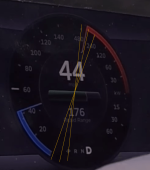Ohbse
10 kW
okashira said:Poking around... It looks like the P85D is rather over-rated. They probably rate for peak front + peak rear motor power. But the trick is not at the same time.Doctorbass said:okashira said:It's more like 20A. You have to account for voltage sag. NCR18650BE would sag down to 3.2V at 20A.
And only for 5 seconds at a time. So they can deal with smaller conductors....
Great remark :wink:
Doc
Proof:
1.) search for the dyno data on the web, its much lower then expected.
2.) a 2013 P85 (416hp rated) traps at 111.5mph (http://www.dragtimes.com/Tesla-Model-S-Timeslip-25833.html?r=1)
a p85D traps at 115mph. (see motortrend)
It's well known that trap speed is very indicative of power/weight and power. The numbers look more like 480-500hp, not 691, sadly.
That "only" comes out to ~14-16 amps per cell, which a NCR18650BE would handle just fine in 5-7 second bursts.
A BE would sag to 3.4-3.5 V at 15A in a quick burst at 90% SOC. (source review of probably a rewrapped black market chinese NCR18650BE: http://lygte-info.dk/review/batteries2012/Keeppower%20IMR18650%203200mAh%20(Black)%202014%20UK.html)
Do the math and that comes to 500 battery horsepower.
People (and Tesla marketing) appear to have arrived at the 691hp figure by adding together the ratings of the front and rear motors. This is obviously not very accurate. It might be representative of the power potential, but at this moment in time I don't think the battery is capable of delivering the full '691hp' under many circumstances. HOWEVER it really doesn't need to. The idea of validating horsepower numbers with trap speed doesn't really work with electric drive-train. The power curve of a well designed EV is wildly different from a high performance ICE engine. The power curve is more like a table with torque falling continuously as RPM climbs. This naturally doesn't result in amazing high speed performance and can skew the results of empirical testing. It can appear slow from the numbers (430 hp at the wheels in the case of the P85D) but the reality of driving it is completely different. What makes a car fast isn't peak horsepower, it's area under the curve. In the past when I was into ICE tuning I ran many 12 second 1/4 mile passes with a 1490cc 4 cylinder engine from a junkyard in a front wheel drive hatchback. This made a mere 110kw or so, however it made that power over a VERY broad RPM range. Geared appropriately it would embarrass many very expensive vehicles that made 3-6x the power (and cost 5-25x more money)
There's nothing not going to be much around that is going to out-accelerate the P85D on the street, certainly not with less than perfect surface quality. Yeah, you're probably going to lose if you're racing from a 50mph roll or higher but outside of street racing douchbags I don't think anybody will really care.




